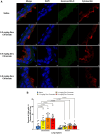Acute particulate hexavalent chromium exposure induces DNA double-strand breaks and activates homologous recombination repair in rat lung tissue
- PMID: 38867691
- PMCID: PMC11347773
- DOI: 10.1093/toxsci/kfae076
Acute particulate hexavalent chromium exposure induces DNA double-strand breaks and activates homologous recombination repair in rat lung tissue
Abstract
Hexavalent chromium [Cr(VI)] is an established human lung carcinogen, but the carcinogenesis mechanism is poorly understood. Chromosome instability, a hallmark of lung cancer, is considered a major driver of Cr(VI)-induced lung cancer. Unrepaired DNA double-strand breaks are the underlying cause, and homologous recombination repair is the primary mechanism preventing Cr(VI)-induced DNA breaks from causing chromosome instability. Cell culture studies show acute Cr(VI) exposure causes DNA double-strand breaks and increases homologous recombination repair activity. However, the ability of Cr(VI)-induced DNA breaks and repair impact has only been reported in cell culture studies. Therefore, we investigated whether acute Cr(VI) exposure could induce breaks and homologous recombination repair in rat lungs. Male and female Wistar rats were acutely exposed to either zinc chromate particles in a saline solution or saline alone by oropharyngeal aspiration. This exposure route resulted in increased Cr levels in each lobe of the lung. We found Cr(VI) induced DNA double-strand breaks in a concentration-dependent manner, with females being more susceptible than males, and induced homologous recombination repair at similar levels in both sexes. Thus, these data show this driving mechanism discovered in cell culture indeed translates to lung tissue in vivo.
Keywords: DNA double-strand break; chromosome instability; hexavalent chromium; homologous recombination repair; lung.
© The Author(s) 2024. Published by Oxford University Press on behalf of the Society of Toxicology. All rights reserved. For permissions, please e-mail: journals.permissions@oup.com.
Figures







Similar articles
-
Particulate hexavalent chromium exposure induces DNA double-strand breaks and inhibits homologous recombination repair in rat and human lung tissues.Chemosphere. 2025 Feb;370:143982. doi: 10.1016/j.chemosphere.2024.143982. Epub 2024 Dec 24. Chemosphere. 2025. PMID: 39701314
-
Homologous recombination repair signaling in chemical carcinogenesis: prolonged particulate hexavalent chromium exposure suppresses the Rad51 response in human lung cells.Toxicol Sci. 2014 Nov;142(1):117-25. doi: 10.1093/toxsci/kfu175. Epub 2014 Aug 30. Toxicol Sci. 2014. PMID: 25173789 Free PMC article.
-
Prolonged Particulate Hexavalent Chromium Exposure Induces DNA Double-Strand Breaks and Inhibits Homologous Recombination Repair in Primary Rodent Lung Cells.Biol Trace Elem Res. 2024 Dec;202(12):5653-5663. doi: 10.1007/s12011-024-04136-1. Epub 2024 Mar 18. Biol Trace Elem Res. 2024. PMID: 38499919
-
Carcinogenic Mechanisms of Hexavalent Chromium: From DNA Breaks to Chromosome Instability and Neoplastic Transformation.Curr Environ Health Rep. 2024 Dec;11(4):484-546. doi: 10.1007/s40572-024-00460-9. Epub 2024 Oct 28. Curr Environ Health Rep. 2024. PMID: 39466546 Review.
-
Hexavalent chromium-induced DNA damage and repair mechanisms.Rev Environ Health. 2008 Jan-Mar;23(1):39-57. doi: 10.1515/reveh.2008.23.1.39. Rev Environ Health. 2008. PMID: 18557597 Review.
Cited by
-
Particulate hexavalent chromium exposure induces DNA double-strand breaks and inhibits homologous recombination repair in rat and human lung tissues.Chemosphere. 2025 Feb;370:143982. doi: 10.1016/j.chemosphere.2024.143982. Epub 2024 Dec 24. Chemosphere. 2025. PMID: 39701314
-
Transcriptomic analysis of Cr(VI)-induced changes in C2C12 cells during myogenic differentiation.J Trace Elem Med Biol. 2025 Aug 9;91:127714. doi: 10.1016/j.jtemb.2025.127714. Online ahead of print. J Trace Elem Med Biol. 2025. PMID: 40803287
References
-
- ATSDR. 2012. Toxicological profile for chromium. Atlanta (GA: ): US Department of Health and Human Services, Public Health Service.
-
- Barnhart J. 1997. Occurrences, uses, and properties of chromium. Regul Toxicol Pharmacol. 26(1):S3–S7. - PubMed
MeSH terms
Substances
Grants and funding
LinkOut - more resources
Full Text Sources

